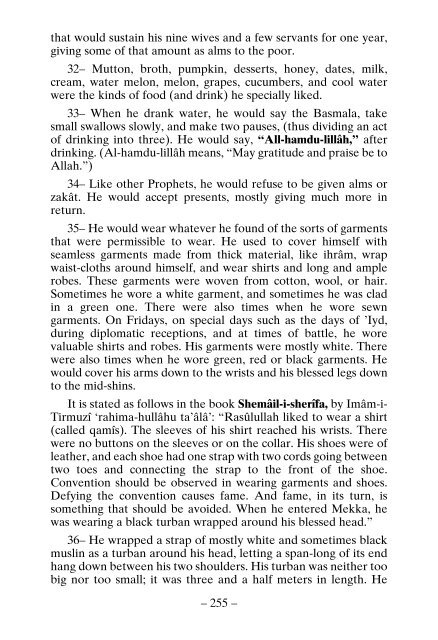Why Did They Become Muslims
WHY DID THEY BECOME MUSLIMS? The book Why Did They Become Muslims consists of 3 sections. Section I is a book of Islam and Christianity. Information about Prophets, books, religions (Judaism, Christianity and Islam) is given, conditions of being a true Muslim are explained, the words of those filled with admiration for Islam and the lives of 42 people who being a member of other religions chose Islam are narrated. Section II is a book of the Qur’an-ı Karîm and the Torah and the Bibles as of Today. Information about today’s Torah and Bibles is given, errors in the Bible are explained; that the Qur’an-ı Karîm is the last and unchangeable book is explained scientifically. Besides, explained are miracles, virtues, moral practices and habits of Muhammad ´alayhissalâm. Section III is a book of Islam and Other Religions. That Islam is not a religion of savageness, that a true Muslim is not ignorant, that there can be no philosophy in Islam are explained along with explanations of primitive religions and celestial religions.
WHY DID THEY BECOME MUSLIMS?
The book Why Did They Become Muslims consists of 3 sections. Section I is a book of Islam and Christianity. Information about Prophets, books, religions (Judaism, Christianity and Islam) is given, conditions of being a true Muslim are explained, the words of those filled with admiration for Islam and the lives of 42 people who being a member of other religions chose Islam are narrated. Section II is a book of the Qur’an-ı Karîm and the Torah and the Bibles as of Today. Information about today’s Torah and Bibles is given, errors in the Bible are explained; that the Qur’an-ı Karîm is the last and unchangeable book is explained scientifically. Besides, explained are miracles, virtues, moral practices and habits of Muhammad ´alayhissalâm. Section III is a book of Islam and Other Religions. That Islam is not a religion of savageness, that a true Muslim is not ignorant, that there can be no philosophy in Islam are explained along with explanations of primitive religions and celestial religions.
Create successful ePaper yourself
Turn your PDF publications into a flip-book with our unique Google optimized e-Paper software.
that would sustain his nine wives and a few servants for one year,<br />
giving some of that amount as alms to the poor.<br />
32– Mutton, broth, pumpkin, desserts, honey, dates, milk,<br />
cream, water melon, melon, grapes, cucumbers, and cool water<br />
were the kinds of food (and drink) he specially liked.<br />
33– When he drank water, he would say the Basmala, take<br />
small swallows slowly, and make two pauses, (thus dividing an act<br />
of drinking into three). He would say, “All-hamdu-lillâh,” after<br />
drinking. (Al-hamdu-lillâh means, “May gratitude and praise be to<br />
Allah.”)<br />
34– Like other Prophets, he would refuse to be given alms or<br />
zakât. He would accept presents, mostly giving much more in<br />
return.<br />
35– He would wear whatever he found of the sorts of garments<br />
that were permissible to wear. He used to cover himself with<br />
seamless garments made from thick material, like ihrâm, wrap<br />
waist-cloths around himself, and wear shirts and long and ample<br />
robes. These garments were woven from cotton, wool, or hair.<br />
Sometimes he wore a white garment, and sometimes he was clad<br />
in a green one. There were also times when he wore sewn<br />
garments. On Fridays, on special days such as the days of ’Iyd,<br />
during diplomatic receptions, and at times of battle, he wore<br />
valuable shirts and robes. His garments were mostly white. There<br />
were also times when he wore green, red or black garments. He<br />
would cover his arms down to the wrists and his blessed legs down<br />
to the mid-shins.<br />
It is stated as follows in the book Shemâil-i-sherîfa, by Imâm-i-<br />
Tirmuzî ‘rahima-hullâhu ta’âlâ’: “Rasûlullah liked to wear a shirt<br />
(called qamîs). The sleeves of his shirt reached his wrists. There<br />
were no buttons on the sleeves or on the collar. His shoes were of<br />
leather, and each shoe had one strap with two cords going between<br />
two toes and connecting the strap to the front of the shoe.<br />
Convention should be observed in wearing garments and shoes.<br />
Defying the convention causes fame. And fame, in its turn, is<br />
something that should be avoided. When he entered Mekka, he<br />
was wearing a black turban wrapped around his blessed head.”<br />
36– He wrapped a strap of mostly white and sometimes black<br />
muslin as a turban around his head, letting a span-long of its end<br />
hang down between his two shoulders. His turban was neither too<br />
big nor too small; it was three and a half meters in length. He<br />
– 255 –

















